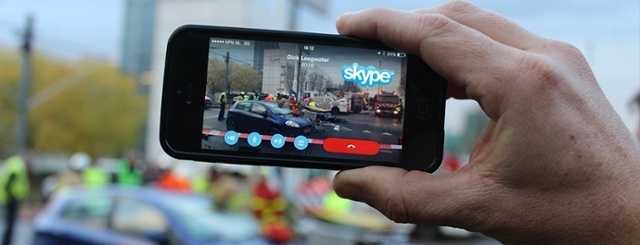Imagine a breaking news situation. You want to get a live feed, interviews and images on air as quickly as possible, but it's a location that is difficult for a satellite truck to reach or you don’t have access to a truck at all.
So, how do you get your on-location content on air? Well, to start with, almost all of us are already equipped with a highly competent video camera with a built in live Up-Link...

Journalists are on the scene in a heartbeat and ready to report, but it takes time to get on-air with an Up-Link truck or a fly-away kit, set up your broadcast camera, lights and audio equipment. That's precious time that you might not always have. What's a 21st-Century Reporter to do? Today, we are all equipped with highly competent video camera with a built in Up-Link, it just happens to also be your smartphone.
A smartphone is an extremely powerful tool for your live production. It's hard to beat the portability of a mobile phone. When combined with external equipment such as a microphone, a tripod and even an led light, your entire live production kit will fit easilly into your carry on luggage.
Using proven, standard tools such as Skype, Google Hangouts or Facetime, combined with the right infrastructure, it's never been easier or faster to get your live feed or interview on air.
Does it really work well for live broadcast applications?
Streaming quality will vary based on your data bandwidth. Your live feed might be highly compressed, but as long as you have a connection you can get something on air. With the speed that mobile networks are being built out, there are very few places remaining in the world where there is no connection at all. In major cities, you typically have access to 4G/LTE networks which allow decent quality streaming.
Your viewers will occationally tolerate highly compressed video feeds, but in an interview situation your audio must be high quality. Using the built-in microphone on your phone will not be good enough for anything else than basic ambient audio, but for a proper interview - it's a no-no. Fortunately, there are a variety of solutions available, including wireless microphones that will connect to your smartphone. If you are planning to conducting a proper interview using your smartphone, investing in a professional external michrophone is an absolute must.
More on using a Mobile Devices for News Gathering:
The most important tool in your toolbox might be your Toolbox.
You will need to convert your Skype, Google Hangouts or Facetime live feed to SDI back at your facility. There are lots of different solutions available to accomplish this task, including hardware scan converters that will convert a signal from your computer to SDI, but there is more to it than that to take into consideration.
Maybe you want to route PGM video to the reporter's smartphone on location, and you want to be able control lipsync. Return audio feeds? How to properly cue your onsite reporter in a live environment?
Today, there are systems such as ChyronHego's Vidigo Toolbox that is designed to help you get your Skype or Google Hangout interview on air in seconds, with full control of audio and video return signals.
Conclusion
Using your smartphone for an interview or broadcasting a live feed from a remote location won't beat a fully professional setup with cameras, lights and an Up-Link truck. However, when used appropriately and in conjunction with tools designed for the task, a smartphone with Skype, Google Hangouts or Facetime could very well be your most important piece of equipment.




